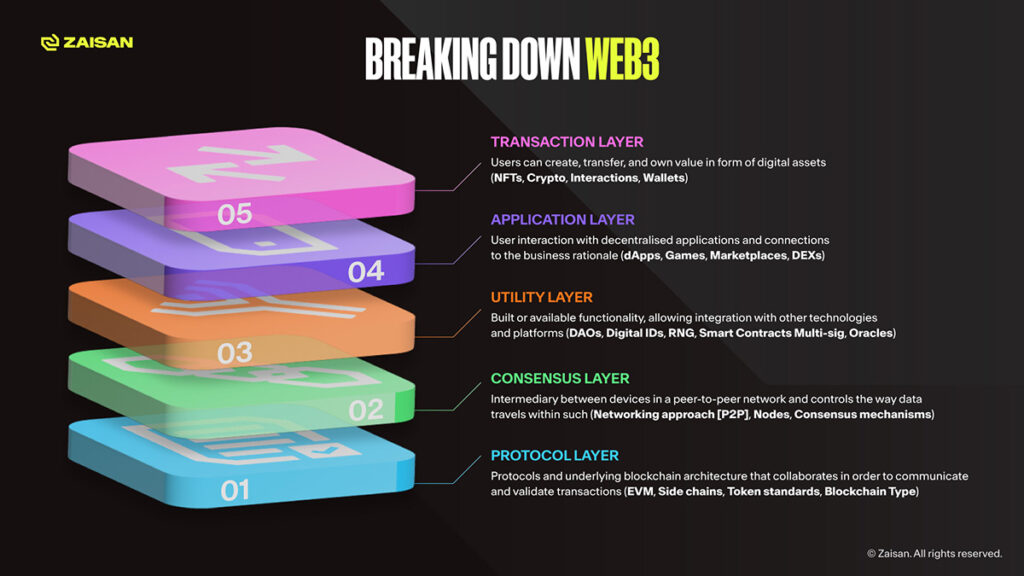While opinions about the actual impact of web3 are widespread, web3 is certainly gaining traction and will continue to do so in the coming years. Various web3 technologies have the ability to disrupt the status quo and have also highlighted new ways of managing data, while encouraging decentralisation. All in all, while the future for web3 is bright, more and more companies will have to adopt the technology in order for it to be the success it can be. Let’s take a deeper dive!
A brief overview of web1 and web2
To understand web3 and everything it is, and is not, it is important to first understand web1 and web2. As the name suggests, web1 and web2 are the technologies preceding web3. We will explain each of them below.
Web1: Simple, static, uninteractive
Web1 is an umbrella term for all the first web technologies. Unlike current web pages, pages in the web1 era, pages were simple, read-only, and anything but interactive.
This era was the start of the world wide web, allowing everyone around the world with an internet connection to access all the available information online. During this period many people created their own websites which contained all kinds of information, from vacation pictures to encyclopedias. The website owner maintained these pages and they contained no such things as a social aspect, dynamic content, or smart features.
Web2: The social revolution
As technology moved forward, web pages started getting more and more advanced. This allowed developers to create more interesting and interactive web pages, which marked the start of the web2 era.
In the web2 era, people are not just reading pages, they are also interacting with them and with other people. Websites that embrace the social aspect of the web like Facebook, Twitter, and Youtube were founded in this period and have become incredibly popular.
Another key part of web2 is e-commerce. While web1 pages occasionally offered products through awkward catalogue-like pages, web2 pages feature easy-to-navigate webshops with integrated payment methods. This led to online shops like Amazon gaining massive popularity.
All in all, the web2 era is characterised by interactivity.

What is web3?
Now you are familiar with the past and present, it is time to move on to the future. Web3 is a relatively new term, and there is no consensus on what it means exactly. However, it is universally agreed upon that web3 refers to the next generation of web technologies that will likely dictate what our digital future will look like. But what does this mean exactly?
One of the core values of web3 is decentralisation, and web3 has various key blockchain technologies that enable this vision of decentralisation, such as cryptocurrency, self-sovereign identity, NFT, and more. In order to get a better understanding of what this means, let’s explain what each of these terms mean in the web3 context:
- Blockchain: The underlying technology of many web3 applications. In essence, blockchains are nothing more than a constantly growing list of transactions. They are linked together using cryptography, often being managed by a network of decentralised entities.
- Cryptocurrency: The finance layer on top of blockchain technology. Cryptocurrencies are tokens on top of a blockchain that can be exchanged between people using a blockchain. These kinds of cryptocurrencies are often managed in a decentralised way. This means the network (and its participants) decide how the tokens are created and distributed.
- Self-Sovereign Identity (SSI): The ability for individuals and organisations to own and control their identities, without intervention or interference from any third parties. In this context, ‘self-sovereignty’ refers to the ability of the individual or the organisation in control of the identity to share it and present it to other agencies with no intermediaries.
- Non-Fungible Token (NFT): In short, a non-fungible token is a token that represents a unique object. An NFT is unique, meaning there is no 100% similar NFT. They are the opposite of regular/fungible tokens, which are all similar and interchangeable. Another key difference between regular tokens and NFTs is that NFTs are non-divisible. NFTs allow the tokenisation of both digital or physical objects.
In essence, web3 is nothing more than an umbrella term for the next generation of (web) technologies. And together, the technologies described above form the basis for web3. However, the definition of web3 and all the concepts and technologies associated with it are not set in stone. As time and technology move forward the definition and impact of web3 will become more clear.

The technology of the future?
Technology is moving forward at a fast pace. The first smartphone with internet connectivity was introduced only 20 years ago, yet a world without smartphones seems almost unimaginable these days.
The same goes for web technologies. What started as a simple way for people to access information, has grown to become an integral part of our lives. Web technologies have evolved a lot over the years, with the latest and greatest technological advancements being referred to as web3. Only the future can tell whether it will actually be impactful. But one thing is certain, it is exciting to see technology moving forward!




